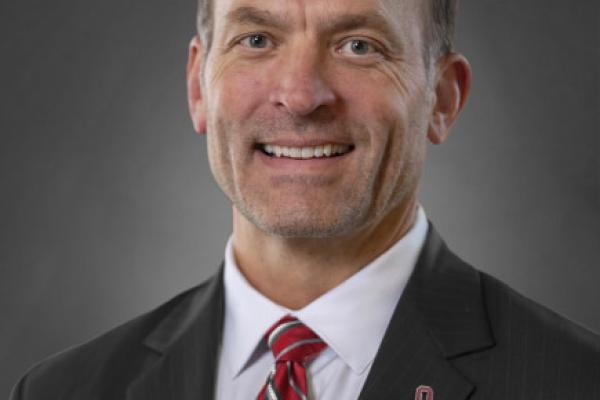Ohio State Athletic Director Ross Bjork Shares Vision for Future, NIL, and Tradition in Exclusive Interview

By Olivia Riley
Ross Bjork was on his 83rd day as Ohio State senior vice president and Wolfe Foundation-Eugene Smith Endowed athletics director when he sat down Sept. 16 with SSI Director Nicole Kraft to discuss his vision.
He has already hit the ground running.
With over 30 years of experience in intercollegiate athletics, Bjork is excited about the ever-changing field: from what’s next with Ohio State’s athletic facilities to the impact of name, image, and likeness (NIL) policies. Here are the highlights of their conversation.
A New Role
To begin the webinar, Bjork touched on his adjustment to the position, as well as what it’s been like to follow Gene Smith, who led Ohio State Athletics for nearly two decades. Bjork previously served as Texas A&M’s athletic director from 2019 to 2024.
“Ohio State is Ohio State,” Bjork said. “The bus for this job only stops once in your lifetime.”
Challenges
Bjork said the lack of clarity surrounding the new facets of college athletics has been one of the biggest obstacles. As the field moves further away from amateurism and closer to a professional-level business model—without college athletes being classified as “employees”—it’s hard to define who’s in charge.
“We’ve got to build a governance structure that allows us to have authority without the threat of a lawsuit,” Bjork said.
Project 36
Though some have speculated that Bjork’s time at Ohio State could bring cuts to some of the university’s 36 sports, he said that’s not the goal. While the number of sports may not change, how Ohio State spends its budget will.
With an annual budget of $285 million to $300 million—the largest of any program in the country—sports will be tiered in terms of revenue sharing and allocated scholarships:
- Tier 1: Sports with scholarships and revenue sharing
- Tier 2: Sports with scholarships but no revenue sharing
- Tier 3: Sports with neither scholarships nor revenue sharing
Bjork emphasized that health, safety, and academic support will not be jeopardized under the new model. The administration is still working to determine what will best serve Ohio State and its athletes.
NIL
Bjork endorsed the idea of athletes earning money from their name, image, and likeness when done in the right environment. In the past, universities have had to keep an arm’s length from NIL, but Bjork said the goal is for Ohio State to be more involved.
“We think there’s a great NIL ecosystem that can be rebuilt and remodeled in this new environment,” he said.
With the House v. NCAA case entering its settlement phase, Bjork hopes the decision will provide clarity on the NIL model for student-athletes. He also noted concerns about donor fatigue in relation to NIL but said he hasn’t seen it happen yet.
Athletic Facilities
“You won’t be able to get away with having subpar facilities,” Bjork said.
He highlighted the importance of housing athletes in top-tier facilities, ideally keeping them in the athletic district. Regarding the future of St. John Arena, Bjork said no decisions have been made about the space.
Ohio State Tradition
In a place as historically rich as Ohio State, tradition is important. Bjork said he wants to strike a balance between honoring tradition and propelling Ohio State forward. He also supports keeping ticket prices at a moderate level for Buckeye fans.
“The way I look at it is, how do we honor tradition without thinking traditionally?” Bjork said.
Title IX
More than 50 years after the passing of Title IX, Ohio State continues to prioritize matching scholarship dollars and financial aid for female athletes. With Ohio State’s student body being about 51% female and 49% male, those dollars, along with roster limits, must reflect the proportionality of the campus, Bjork said.
The university is seeking guidance on how to handle revenue sharing between teams under Title IX guidelines and is consulting other NCAA and Big Ten schools.
Big Ten Expansion
The Big Ten continues to grow, with recent additions of Oregon, Washington, USC, and UCLA. Ohio State athletes could now be traveling upwards of 4,000 miles round-trip for a single weekend.
Bjork said the physical toll on student-athletes must be considered in this new conference era.
“We’ll have to be more efficient in our travel,” he said.
Bjork also mentioned that the revenue from these high-profile matchups is becoming too significant to ignore and could lead to economic consolidation. Television agreements, which begin to unwind in the late 2020s and early 2030s, may dictate future opponents.
2024 Football
“Ohio State is always under pressure to perform at the highest level,” said Bjork, who played fullback at Emporia State from 1992 to 1994. “I’d rather have that than try to create it.”
He praised the culture and environment coach Ryan Day has fostered for the football team this season and noted that this year’s coaching staff adjustments have been helpful.
With the College Football Playoff expanding, a longer season, and challenging road games like Oregon and Penn State, there’s less margin for error. But Bjork expressed confidence in the depth of the Buckeye roster.
“Play the game. Let’s have fun and enjoy every moment in the ’Shoe. Let’s enjoy these road games,” he said. “Let’s just take it one step at a time.”
Looking Ahead
Now in his third month leading one of the largest athletic departments in the country, Bjork has had time to reflect on the legacy he wants to leave at Ohio State. As the university’s ninth athletic director, he emphasized the importance of a long-term approach and the goal of leaving Ohio State better than he found it.
“We’re not going to shortcut anything. Yes, it’s a new era. Yes, we’re trying to be aggressive. There’s no question about that,” he said. “But we can still do it in a principled manner if we keep the institution first.”
